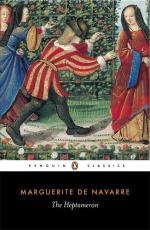Forthwith, having no regard for the duty that he owed his mistress or for the house to which she belonged, he got into bed with her, without entreating her permission or making any kind of ceremony. She felt him in her arms before she knew that he had entered the room; but being strong, she freed herself from his grasp, and fell to striking, biting, and scratching him, demanding the while to know who he was, so that for fear lest she should call out he sought to stop her mouth with the bedclothes. But this he found it impossible to do, for when she saw that he was using all his strength to work her shame she did as much to baffle him. She further called as loudly as she could to her lady of honour,(7) who slept in her room; and this old and virtuous woman ran to her mistress in her nightdress.
7 The lady in question was Blanche de Tournon, daughter of James de Tournon, by Jane de Polignac, and sister of Cardinal de Tournon, Minister of Francis I. She first married Raymond d’Agout, Baron of Sault in Provence, who died in 1503; and secondly James de Chastillon, Chamberlain to Charles VIII. and Louis XII., killed at the siege of Ravenna in 1512. Brantome states, moreover, that she subsequently married Cardinal John du Bellay. (See Appendix to the’present volume, C.) In this story, Margaret describes the Princess of Flanders as having lost two husbands, with the view of disguising the identity of her heroine. Her own husband (the Duke of Alencon) was still alive; but Madame de Chastillon had twice become a widow, and the Queen, who was well aware of this, designedly ascribed to the Princess the situation of the lady of honour. This story should be compared with the poem “Quatre Dames et Quatre Gentilhommes” in the Marguerites de la Marguerite.—F.
When the gentleman saw that he was discovered, he was so fearful of being recognised by the lady, that he descended in all haste through his trap-door; his despair at returning in such an evil plight being no less than his desire and assurance of a gracious reception had previously been. He found his mirror and candle on his table,(8) and looking at his face, all bleeding from the lady’s scratches and bites, whence the blood was trickling over his fine shirt, which had now more blood than gold (9) about it, he said—
8 It is not surprising that the mirror should have been lying on the table. Mirrors were for a long time no larger than our modern hand-glasses. That of Mary de’ Medici, offered to her by the Republic of Venice, and now in the Galerie d’Apollon at the Louvre, is extremely small, though it has an elaborate frame enriched with precious cameos. Even the mirrors placed by Louis XIV. in the celebrated Galerie des Glaces at Versailles were no larger than ordinary window-panes.—M.
9 Shirts were then adorned at the collar and in front with gold-thread embroidery, such as is shown in some of Clouet’s portraits.




